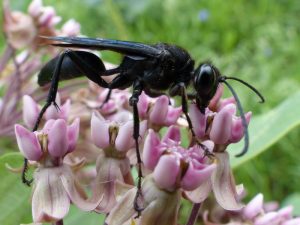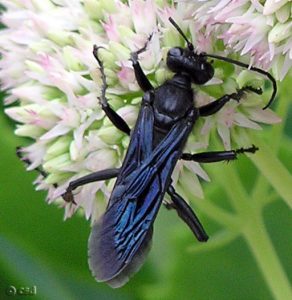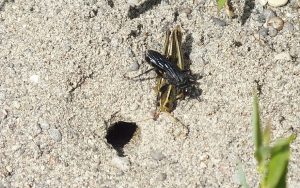What is the Great Black Wasp?
The Great Black Wasp is a remarkable large black wasp, as the name suggest. It is also known as Katydid Hunter and Steel-blue Cricket Hunter. It belongs to the Sphecidae family (the thread-waisted wasps or digger wasps) and Hymenoptera order (ants, bees, wasps).

The Great Black Wasp
Its length is approximately 1 to 1 ½ inches where females are slightly larger than males. It’s a mono-colored wasp with no noticeable patterns on its body. However, its smoky black wings cast a rather blue iridescence when flying during the warm summer months.
The body of the great black wasp is described as satiny black with a narrow constriction between its thorax and abdomen. Its shiny black wings are usually folded together lengthwise at its back. The mandibles (mouth area) are overlapping and held together. It has a rather large and sickle-shaped with an extra prong in each curve. The legs are really long and spiny.
Life Cycle of the Great Black Wasp
Belonging to the wasp species, the great black wasp also undergoes a complete metamorphosis as an egg, larva, pupa, and adult.
The great black wasps are solitary wasps. After hatching, they are pretty much on their own. The female wasp normally digs a multi-chamber hole in the ground, captures a grasshopper or a katydid, lay her single egg in each chamber after mating. Using her strong mandibles, it then captures two more insects as food for the single egg when it hatches as larvae. The multi-chamber hole will serve as a nursery to the eggs.
Upon hatching, the larvae will easily devour the insects provided for them, then they will pupate and become adults eventually. As adults, the great black wasp will now eat nectar and pollen from the flowers.
The Great Black Wasp Habitat
Unlike their yellow jacket wasp cousins, great black wasps are solitary wasps and do not live in colonies. Most of them are found in the eastern 2/3 of the United States.
They are subterranean wasps that prefer to live in areas where their prey are located such as pastures, residential

Female Great Black wasp
areas, and meadows. Basically, you’ll see a great black wasp in areas where there are gardens, landscaping plants and flowers. In addition, since adult great black wasps prefer nectar for food, they often take habitat in gardens, where they are surrounded by flowers.
The Great Black Wasp Nest
Since they are subterranean insects, their nests are found underground where a female wasp cares and provides food for her offspring. Usually hunting for “fleshy” smaller insects with its sting, the female wasp brings food to its nest below ground.
The nest is usually constructed in a soft, well-drained soil. The nest is made up of a multi-chamber tunnel that a female wasp make out of 2 to 6 paralyzed prey which serves as food for its larvae. Once an egg chamber is ready, the female will now deposit an egg on the prey and close the chamber. When all egg chambers are filled with eggs and with sufficient food, the female wasp will close the nest by compressing soil around the entrance of the tunnel.
The Great Black Wasp Sting
Unlike other colony wasps, the great black wasps do not rely on anyone to defend themselves from an enemy. Despite the name, they are actually not considered as aggressive insects. In fact, only females can sting, which they mostly do just to hunt for preys. Unless provoked or threatened, the great black wasp is not at all considered dangerous.
Great Black Wasp Removal
There is usually no reason for controlling great black wasps, considering how they are helpful in preying on harmful garden pests. Not to mention, they are also great pollinations. However, its huge size usually causes an alarm to

The Great Black Wasp Nest
some. When this happens, you can try some of the following:
- Limit food source. You should keep the flowers and plants (especially those with sugary nectar) indoors. If the food source is scarce, then the wasp will look for another habitat.
- Make a fake nest. Get a paper grocery bag and a twine. Crumple the bag and you can hang it near the existing nest of the wasps where they can notice it. GBWs are territorial and if they see there’s another colony living in the area, they will not build a nest in there.
- Attack at the right time. During summer, it is best to go after these wasps at night time, since they are rather active when the climate’s warm. When the coldest months of the year come, the wasps will die off all at once. This is the right time to get rid of old nests and hang up the fake nests to ensure that they will not come back.
- Use a non–toxic spray. Fill a hose-end sprayer with dish soap and water and attach it to your garden hose. Spray it on the nest of the wasps, ensuring you’re standing a good distance and wearing a protective clothing just in case the pests become aggressive.
Since these wasps are solitary beings, it’s highly unlikely they’ll stick around to be a nuisance.

I have a nest, colony, home of these GBW’s in my attic. I live in an older home, and alot of our attic is unreachable. I hung up a fake nest, but I am too afraid to go into the attic where I usually find them. The attic has no heat or air conditioning, so it being summer my attic is blasting with heat. Can these bees survive high temperatures? Will they move of the temperature stays high?
I have great black wasps with iridescent blue wings that are destroying
my perennials. They create deep holes, sometimes nearly a foot
around and in the center. The only treatment I use is a 12/ c. of pyrethrin
in a gallon of water. That is sometimes successful. Still, I’ve lost
over 11 newly perennials for my small butterfly/hummingbird garden in NE Florida just this year alone. This predator is definitely not a vole or a mole. I’ve seen them in action. Please advise. I have a photo. Many thanks.